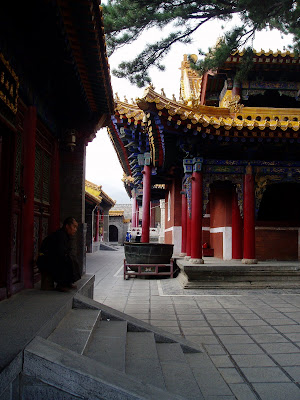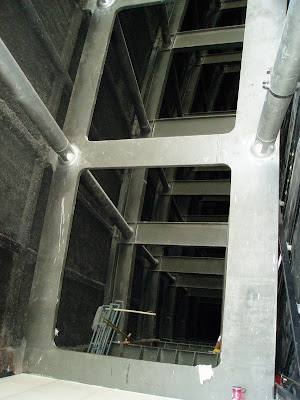travels with unka bill
pinning a tail on william rogan, in china and beyond...
Wednesday, December 17, 2008
Wednesday, November 12, 2008
20: to the states via eastern europe
for this return visit, i had plotted out a round-the-world train trip: the 6-day mongolian express from beijing to moscow was to be my first leg, and then on to late-october birthday parties in zurich via berlin. from there i'd planned some stops in eastern europe, then on to london by eurostar, then dublin by train and ferry. from there i would fly to new york, make my usual u.s. circuit by train, get to seattle in time for mom's 85th birthday on thanksgiving weekend, and fly back to beijing on the first of december. things didn't turn out that way...
the mongolian express was the first casualty, as tickets weren't confirmed until after i was committed to a presentation for the office; later tangles forced me to lop off zurich, too. i finally got away on a hong kong-to-london flight, and caught a ryan air connection back to zadar, croatia, to visit with my old friend darko franceschi.


darko had worked with me for several years in the states, and we had made several american road trips together. now i was to see my dalmation friend in his native habitat. he has set himself up in his family's vacation house in the village of petrcane, just a few minutes up the adriatic coast from the bigger city of zadar. follow the coast north and west, and you'll hit venice (in about 5 hours by car).




pretty spectacular set-up, huh? darko has his studio set up on the second floor; with such a view, i'd never get anything done...
at the tip of the point where the house is sited, there is a big resort development underway; previously, it had been the largest nudist colony in europe. soon the nekkid germans will be replaced by big hotels and condos. this is the view back to petrcane from the point.

he took me to visit nin, a nearby roman village that has long been a salt works. there we found what they call the worlds' smallest cathedral; several other early christian buildings in the area, too.


the other churches in the village were packed for sunday mass, and since it was a few days after all saints day, the waterfront cemetery was all decked out and full of visitors.


zadar is also a roman town, though much larger. the venetians had ruled the place occasionally, and there was a fair amount of destruction during world war II. the most recent war spared the town for the most part. today's fabric is an interesting mix of eras, with a good bit of 1960's postwar infill, surprisingly sensitive and successful.



Wednesday, October 22, 2008
19: shanxi province

at the end of august, the office made a junket out of getting some history lessons for the staff. about forty of us flew to taiyuan (several hours north and west of hangzhou) to explore the yellow plains, what is considered to be the cradle of chinese civilization. this is the furthest inland i have yet been, and from what i'm told, it is the closest to what all of china was like thirty years ago: gritty and poor, and every meal looks the same. i am accustomed to getting stares by now; in shanxi, an exotic outsider like me rates slack-jawed amazement.

first stop was wu tai shan, a tibetan buddhist monastery on a sacred mountain, some parts dating from 400 a.d. the government has obviously spent big bucks sprucing this up (new paving and fresh paint most apparent) but with ancient trees and intimate spaces, it is still quite a production. breezy and quiet, it's hard to believe you are still in china!

we were ferried up the mountain to the rear gate of this complex, so we experienced it backwards. when i got to the front gate, and had a look at the climb it would take to get up here, i figured out why this place was so quiet! even the descent was rugged; monks never seem to settle on a site that is an easy commute...

lots more temples down below. one of the more interesting things here was the whitewashed masonry temple, below on the right. at first i thought it was a 1890's hybrid, influenced by the west.

once inside, the massive piers, stepped vaulting and the powerful simplicity of the whole blew that theory away: this is early ming dynasty. it still imitates timber bracketing on the exterior, but the interior serenity is another place altogether.

the gold of the temple and prayer wheels here is laid on copper; pretty dazzling on such a beautiful day, and a particularly nice counterpoint to the whitewashed masonry.

next stop was a qing (pronounced "ching") dynasty clan compound in an older farm village, unusual in that it was all built at one time. the labrynthian layout that often evolved in uplanned development is an intentional design feature here.

the compound served as kuo ming dong (nationalist) stronghold during the revolution; the victors of the communist party kept the place in shuttered obscurity for years, but now some limited dusting-off of such relics feeds growing appetite for domestic tourism.

the texture of the crumbling, older village was most interesting to me, however. the late qing dynasty was the last gasp of the imperial era, and remaining structures can seem almost familiar to us- same era as victorian remnants in the west. but fragments of "old" china are still there for the finding; notice the wagon ruts in the stone pavement, and the exotic nail head pattern in the gate below.

nearby, an older village was another hybrid: an archaeologic site in a living community. the masonry screens, intense sunlight and the intricate shadows here reminded me of north africa. travelers along the silk road must have thought the same thing...


we stayed in a guesthouse in the walled ancient town of pingyao. most buildings here are again from the qing dynasty...

but with some local personality: the masonry arches here are parabolic, as opposed to the rounded "roman" style found elsewhere, for instance...

it is another "living" village, but the government has put a lot of effort into developing it for tourism. the town is divided into quadrants by main streets; the mid-street belltower below marks the crossing of the axes. the rest is the typical chinese texture of courtyards, lanes and alleys...

the grand finale was this tang dynasty temple complex back near taiyuan; the chinese name translates into roughly "thank your mom". the grounds are extroardinary, another occasion when you wonder if you are still in china.

as you move up the axis you pass several structures, including this one below, the treasure house, for stacking up all that giftware for mom. it looks like it's been substantially rebuilt, but check out the authentic bracketing here...

and now you get to the main event. this wooden structure dates from 900 a.d., one of the oldest structures in china. the ancient cypress trees, however, have been pegged at some three thousand years old!

there's a spring that bubbles up in front, and a unique bridge structure takes you across. the stonework looked suspiciously new to me, but i recently found a photo from the 1930's that shows it was there then.

the dragons are the most memorable feature of this one, and make it easy to recognize.

and the bracketing is great; all the pieces here are functional in holding up and extending the reach of the massive roof. in later buildings, much of this degenerated into decoration: by the time of the forbidden city, most of the bracketing is fake, and actually burdens the structure, rather than reinforcing it.

the springs are diverted into some pools to the west side- presumably for bathing. the springs are reputed to have some restorative powers; i guess that's why you bring mom here, for some fountain-of-youth therapy.

these fearless old ladies seem determined to check it out...

everybody invested in some payback for mom: an emporer recorded planting these ginkos some 600 years ago, to grace another temple near the pools.

i soaked my feet here for a bit (not interested in living forever) and headed back to hangzhou.
Tuesday, July 08, 2008
18: beijing bulletin

i made a quick trip to beijing a few weekends in advance of the olympic crowds to check out all the new buildings with shanghai architect and friend, paul rice.
it seemed every farmer in northern china was at work there, planting impatiens or tending flowerbeds and shrubbery, everywhere you looked. normally you don't see much grass in china- people prefer edible produce over decorative lawns- but for all the foreigners, they were rolling out the green carpet. never have i seen beijing so clean and inviting; the weather was fantastic, the skies sparkling and blue like i've rarely seen before. even the residents looked scrubbed-up and more and cheerful, eager to speak some english and "assist" you, whether you wanted it or not.
the olympic park was already locked down, with increasing security. where earlier, one could stroll past the guards and get up close and personal with construction crews, international television crews setting up equipment were protected by rings of armed soldiers. batteries of ant-aircraft missles around the birds nest had yet to be camouflaged, and the roof of the nest itself had sprouted some sort of inflatable, shrouded carbuncle that (if not espn or nbc) i assumed was military in nature, too; turns out it was the flame cauldron, under wraps until the opening ceremony.
the collective sense of humor was sharp as ever, and taxis were pedal-to-the-metal to get you to the other beijing destinations that a few months ago, they knew nothing about. now they even have their own nicknames for the biggest stars: first is "big shorts", the new cctv headquarters (rem koolhaas), and another is "the egg", the new national theatre (paul andreu).
for a more complete look at these, there is a great interactive feature with maps, diagrams and commentary in the nytimes, july 12 arts section; i'll try and attach a link here:
http://www.nytimes.com/interactive/2008/07/12/arts/20080712_BEIJING_
GRAPHIC.html?ex=1216612800&en=069af2c44ad9d7ef&ei=5070&emc=eta3


non-architect friends will probably recognize these shots most readily, as i think it was featured prominently in the nbc olympic coverage of the new whiz-bang beijing architecture: the new cctv (china central television) tower. i've grown from loathing it (in sketches) to loving it (in person); i had the same relationship with his seattle public library.
this monster is visible from all over town, and the form is constantly changing, depending on where you are. the scale is difficult to comprehend (much like the whole of beijing) and the dramatic tension of the cantilevered ledge is yet to be fully experienced, as the 15-meter-high construction fence keeps everyone at a distance, for now. but the composition extends further down the site, with the folded-metal planes of the attached hotel and service structure.


all in all, it's a very cool project; the frizzy "tension lines" criss-crossing the glass curtain wall are quite expressive, and make the form even more dynamic. the guy really handles his materials with finesse- it's not just wallpaper.
rem koolhaas, i'm a born-again... again!
mr. andreus, however...
after a trip inside, this egg thing is a bigger mess than i dreamed possible. on an earlier visit, while still under construction, i'll admit to being a little seduced: few places on earth could digest the huge abstraction he's pulled off here. with tiananmen square and the forbidden city as neighbors (even the google satellite view is breathtaking), how DO you establish any scale here? this shot is from my december visit, as workmen were washing off the gobi-dust for the grand opening; see the little critters on the ropes?

the complicated program, calling for three theatres and all the rest, certainly needed some grand, unifying gesture; the elaborate model studies of other competition entries on display in the lobby show how many other architects grappled with the same problem.
his solution was wrapping everything a titanium egg, and setting it afloat in a reflecting pool. access to the interior takes everyone under the water; the blue pool-floor panels in the shot above are the skylites in the one below.

you'd think this captain-nemo trick would be pretty cool- but in reality, even in bright daylight, it's pretty limp; after dark, you barely notice it. it's hardly a payoff after the grim introduction, through what could easily be mistaken for just another subway entrance. paul and i even argued about which side WAS the main entrance; we approached the egg from the south, as i had on my first visit. an inclined disc of geometric stairs and planting invites your descent to a modest slot leading under the pool. paul insisted this was the back door- the guards proved him right, and they pointed us 180 degrees to the north side, and the bigger, duller sweep of stairs that i had completely missed on my previous visit.
only a foreigner (ignorant of feng shui) could get away with such a north-facing entry in beijing, but the prominent address was clearly chang'an lu, the 12-lane may-day parade route crossing tianamen square, beneath the benevolent gaze the portrait of mao, and the gateway to the forbidden city.
i was wrong. (please note that's the second such admission; life in china does that, even to a control freak like me.)
the architecture critic of the times, nicolai ouroussoff, compared this subterranean approach to the theatre complex to the access tunnels that now regulate pedestrian flow into tiananmen square, effectively separating them from the public realm. he's right.
once you've descended the stairs, bought your ticket, traversed the captain nemo shopping mall, you approach the mighty gate below:


you enter the egg from the bottom of an oval tub; escalators whisk you up to the rim from either side. the first "jesus" moment on arrival is taking in the scale and intricacy of the overarching eggshell.




















